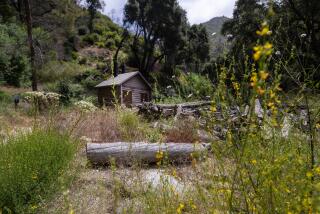Officials Consider Spraying to Save Pines From Bark Beetles
Dogwood Campground near Lake Arrowhead, home to 100-foot-tall Jeffrey pines and squawking woodpeckers, was so adored by campers that federal foresters recently refurbished the area, installing new bathrooms, picnic tables, pavement and barbecue grills.
Just months after the work was completed, however, every mature pine tree on the premises was attacked and killed by bark beetles.
With new swarms expected to attack this spring, foresters are considering a plan to fight back by spraying with insecticide what few healthy trees remain in the San Bernardino National Forest’s popular campgrounds and administrative sites.
So far, 1,681 pines have been targeted for spraying soon at campgrounds visited by about 12 million people annually.
If needed, follow-up treatments could be applied over the next three years.
San Bernardino National Forest Manager Gene Zimmerman said federal entomologists had recommended the treatment as a possible means of protecting the “pleasant and peaceful surroundings” in areas “where we have large investments, such as multimillion-dollar campgrounds.”
“My proposal is to treat these trees before the beetle flight period begins this spring,” Zimmerman said in a recent letter to residents of the region.
“The work should be completed by May 1, and would also be completed by this date in all future years if application is necessary.”
“We’ve already taken more than 1,000 dead trees out of Dogwood Campground, and we desperately don’t want to see that happen at campgrounds across our national forest,” he said.
“As it stands, there’s a lot of sunshine in areas where there used to be lots of shade.”
Still, the proposed spraying, which has been done only twice on federal land here in 25 years, will be restricted to a limited number of trees.
“What I’ve been told by our experts,” Zimmerman said, “is that, despite the good rains we’ve been having lately, we will probably lose a lot of trees this summer because the number of beetles is extraordinarily high.
“Even if the rainfall continues,” he said, “it would take at least a year before we would expect to see appreciable reductions in the numbers of beetles.”
A large swarm of bark beetles can kill a mature pine within 24 hours.
The bugs are smaller than a pencil eraser, but they bore by the thousands into the bark and feast on the moist inner core, where trees store and transport nutrients from roots to needles.
Then the beetles carve egg galleries, where larvae hatch and mature, before emerging to infect other trees.
A blue-stain fungus delivers the final blow, clogging the trees’ circulatory systems.
Healthy pines would simply “pitch out” beetles by drowning them in sap.
But in these drought-stricken mountains, hungry beetles land on stressed trees and quickly emit an odor that attracts millions of brethren.
The proposal calls for spraying individual trees that are bug-free, more than 5 inches in diameter and accessible by roads (to ensure that equipment, including cranes, can reach as high as 80 feet up the trunks).
The trees must also be free of acorn woodpeckers, which use the trees to store food and which could be harmed by the insecticide carbaryl, known as Sevin XLR.
Essentially, Zimmerman said, “the tree should be a high-value tree, meaning it adds an important element to the recreation setting and would be sorely missed if it died and was removed.”
Dogwood Campground’s 50 acres of mountaintop property about five miles southwest of Lake Arrowhead were once blanketed with thousands of pines matching that description.
Over the last year, most have died. Now, crews are cutting them down and reducing them to large mounds of wood chips.
Maneuvering his four-wheel-drive vehicle over a windy campground lane covered with 12 inches of snow, Jonathan Cook-Fisher, a San Bernardino National Forest recreation officer, said, “Before the die-off, this campground had a secluded, cozy feel to it.
“Now, it’s severely diminished, and there’s no easy way out of the bug problem we’re facing.”
Threatened with liens on their properties if they fail to remove dead and flammable trees, some mountain denizens have been spraying pesticides for more than a year.
But Peter Jorris, a founder of the Mountain Rim Fire Safe Council and self-described “organic gardener from way back,” has yet to make up his mind on the question: to spray or not to spray?
“I have Jeffrey pines on my property,” he said. “I may wind up spraying them on grounds that, gosh, we don’t want to lose everything,” he said.
“On the other hand, my old purist organic background may decide to just let nature take its course.”
More to Read
Sign up for The Wild
We’ll help you find the best places to hike, bike and run, as well as the perfect silent spots for meditation and yoga.
You may occasionally receive promotional content from the Los Angeles Times.







